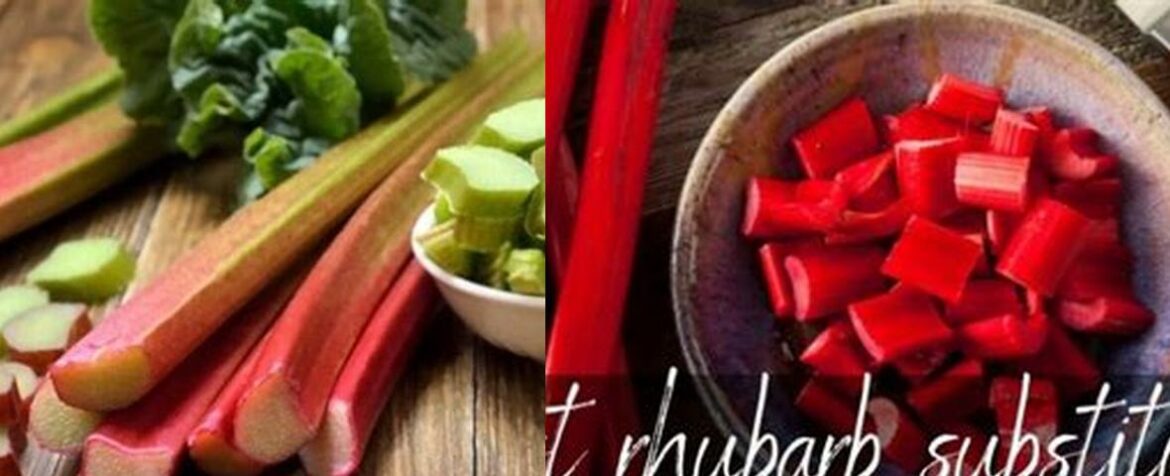Are you tired of relying on rhubarb to add a tangy twist to your recipes? Well, it’s time to break free from the shackles of this tart vegetable and explore a world of flavorsome alternatives! In this blog post, we will uncover the best substitutes for rhubarb that will satisfy your taste buds and elevate your dishes to new heights. Say goodbye to the same old rhubarb and hello to a whole new culinary adventure! So, grab your apron and let’s venture beyond rhubarb together!
Venturing Beyond Rhubarb: Embracing Flavorsome Alternatives
In the realm of culinary arts, rhubarb reigns supreme as a unique vegetable, captivating taste buds with its distinct tartness. Whether gracing desserts, jams, or savory dishes, its versatility knows no bounds. However, when fresh rhubarb eludes availability or personal preference dictates otherwise, a myriad of substitutes stand ready to replicate its tantalizing flavors and textures, ensuring culinary creations remain vibrant and delectable.
1. Strawberries with Lemon: A Sweet and Tangy Symphony
Strawberries, nature’s crimson jewels, dance harmoniously with lemon’s zesty acidity, mirroring rhubarb’s flavor profile with remarkable accuracy. This dynamic duo offers a delightful balance of sweetness and tang, evoking the essence of rhubarb in every bite. When employing this delectable substitute, opt for ripe strawberries, bursting with their inherent sweetness. Complement their natural charm with freshly squeezed lemon juice, not merely zest or peel, to achieve a harmonious equilibrium of flavors.
2. Cranberries: A Tart and Tangy Reflection
Cranberries, renowned for their vibrant red hue and assertively tart flavor, emulate rhubarb’s tanginess with remarkable precision. Their inherent tartness finds perfect harmony when paired with sugar’s sweetness, creating a flavor symphony that tantalizes the palate. Beyond their culinary prowess, cranberries bestow health benefits aplenty, boasting an impressive vitamin C content that fortifies the body’s natural defenses. Whether gracing desserts, sauces, or jams, cranberries emerge as a worthy substitute for rhubarb, delivering both flavor and nutritional value in equal measure.
3. Quinces: A Fragrant and Tart Stand-In
Quinces, often overlooked gems of the fruit world, possess a captivating fragrance and pronounced tartness that mirror rhubarb’s characteristics with remarkable accuracy. Their texture, too, bears a striking resemblance to rhubarb, further solidifying their suitability as a substitute. When incorporating quinces into your culinary creations, treat them with the respect they deserve, allowing their unique flavors to shine through.
4. Tart Apples: A Crisp and Slightly Sour Doppelgänger
Tart apples, such as Granny Smith or Bramley, embody the essence of rhubarb with their crisp texture and slightly sour flavor profile. Their inherent acidity lends itself beautifully to dishes where rhubarb traditionally reigns supreme. When substituting tart apples for rhubarb, maintain a one-to-one ratio, ensuring a seamless transition in both flavor and texture.
5. Raspberries: A Sweet and Slightly Tart Ensemble Player
Raspberries, with their captivating sweetness and subtle tartness, contribute to a flavor profile that harmonizes seamlessly with rhubarb’s distinctive tang. Their versatility shines when combined with other fruits, creating a symphony of flavors that tantalizes the taste buds. When employing raspberries as a rhubarb substitute, maintain a one-to-one ratio, allowing their inherent charm to complement and enhance the overall flavor profile.
Choosing the Perfect Substitute: A Culinary Balancing Act
The choice of substitute hinges upon the dish being prepared. For instance, strawberries with lemon excel in pies and crumbles, while cranberries shine in sauces and jams. Quinces find their niche in compotes and preserves, while tart apples lend their crispness to pies and tarts. Raspberries, with their versatility, harmonize beautifully in both sweet and savory dishes, adding a touch of fruity elegance to each culinary creation.
In conclusion, the world of rhubarb substitutes is a vast and flavorful tapestry, beckoning culinary adventurers to explore the nuances of each ingredient. Whether seeking a sweet and tangy symphony or a crisp and slightly sour counterpart, a wealth of options awaits, promising to elevate culinary creations to new heights of flavor and delight.
FAQ about Substitute For Rhubarb
Q: What can I use as a substitute for rhubarb in sauces or jams?
A: Cranberries can be a worthy substitute for rhubarb, offering both flavor and nutritional value.
Q: Are there other alternatives to rhubarb that I can explore?
A: Yes, there is a vast array of flavorful alternatives to rhubarb that you can try.
Q: Can raspberries be used as a substitute for rhubarb?
A: Yes, raspberries can be used as a substitute for rhubarb, as they contribute a captivating sweetness and subtle tartness that harmonizes well with rhubarb’s tang.
Q: How should I use raspberries as a substitute for rhubarb?
A: When using raspberries as a substitute for rhubarb, it is recommended to maintain a one-to-one ratio to allow their inherent charm to complement and enhance the overall flavor profile.
Q: What other flavors can I combine with raspberries when substituting for rhubarb?
A: Raspberries can be combined with other fruits to create a symphony of flavors. Experiment with different combinations to tantalize your taste buds.
Q: Are there any other substitutes for rhubarb that I should consider?
A: Yes, there are many other substitutes for rhubarb that you can explore. The world of rhubarb substitutes offers a vast and flavorful tapestry, waiting to be discovered by culinary adventurers.


